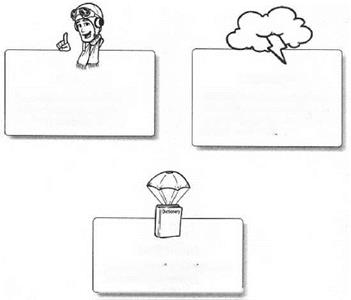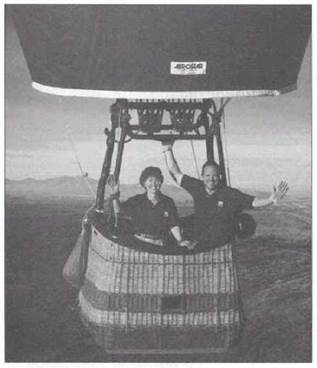Flying and Gliding
Flying! Leaving the bonds of the earth behind and seeing the world from above! It’s been our dream from the beginning of time. But only in the last 200 years or so— mere droplets in the great river of time—have humans realized this dream and enjoyed the wonderful exhilaration of flight.
We’ve reveled in our enjoyment of flying in every way imaginable. We’ve risen above the earth in balloons, airships, airplanes, helicopters, gyroplanes, and gliders— every contraption we can conceive of to take to the skies.
Bill Lane explores it all. Ever wonder what makes an airship or a helicopter fly? The answers are right here. Bill takes you from the ancient dream to modern-day reality and explains how each of these marvelous inventions works. In a delightfully playful and clear style he takes you beyond the mechanics of flight and shares his passion for every type of flying—letting you in on the behind-the-scenes jokes and stories that pilots usually share only with other pilots.
Bill is the perfect person to write this book. He comes by his love of flying naturally. His grandfather was a barnstormer who toured the country with an aerial circus. His father followed as a fighter pilot and then airline pilot. Bill himself learned to fly in high school and became a highly qualified flight instructor while obtaining his degree at Embry-Riddle Aeronautical University. After a career of sharing the gift of flight with others ranging from university students to fledgling airline pilots, Bill became a professional wordsmith, writing for newspapers and magazines on a wide variety of subjects—especially aviation.
With these special skills, Bill brings to you a clear view of the big picture of aviation. Y ou will not only understand the deep satisfaction that pilots get from commanding an aircraft in flight, but you’ll have a perspective on the inevitable risks involved. You’ll realize that the habit all pilots have of talking about crashes among themselves comes not from a morbid preoccupation with death and destruction, but from a lifelong desire to understand and carefully manage the risks of flight.
No matter what it is that fascinates you about flying—its promise of freedom, its beauty, its precision and science, or the prospect of adventure—you will find it all waiting for you in this book. Enjoy it! And who knows—you might just find, like thousands before you have, that you, too, become inescapably drawn to the sky!
JOHN AND MARTIN KING SAN DIEGO, DECEMBER 21, 1999
|
|
John and Martha King have, through the magic of video, instructed more pilots than anyone in the world. Known for their entertaining and personable onscreen style, the Kings have revolutionized the flight-training industry. They have pursued their enthusiasm for Hying to the fullest, Hying their Citation jet wherever they go and swapping captain and co-pilot duties on each leg. They are the first husband and wife to hold every class of pilot and instructor rating available. From airships and balloons to helicopters, gyroplanes, airplanes, and gliders, John and Martha enjoy them all.
What is the appeal of aviation that draws thousands of new pilots to the skies every year? Is it the legacy of brave men like the earliest barnstormers and air mail pilots? Is it the legend of Charles Lindbergh or the mystery that haunts the memory of Amelia Earhart? Or is it the technicalities of flying, the simple forces of nature that enable tons of metal to lift free of the earth and behave like a bird?
By the time you finish reading The Complete Idiot’s Guide to Flying and Gliding, you’ll have a better idea about which aspect of aviation attracts you to this fascinating pursuit. This book is written for the prospective pilot as well as for the spectator who longs for a deeper understanding. The would-be pilot will find it an excellent introduction to concepts that he or she will soon understand in greater depth. And the spectator will come away with a greater appreciation for the sport that already gives him or her immense satisfaction.
What You’ll Learn in This Book.
In The Complete Idiot’s Guide to Flying and Gliding, you’ll learn everything you need to know about the history of aviation, the fundamental physical principles that make flight possible, what it takes to make a flight, the secrets behind the thrilling aerobatics that spice up air shows, and the mental and physical obstacles that face human beings when we go aloft.
Here’s what you’ll find in each part of the book:
Part 1, “Taking to the Sky: The History of Flight,” traces the history of the human race’s fascination with birds, the sky, and dreams of flight. You’ll learn about the influence Leonardo da Vinci had on Renaissance thinking, the French ballooning craze of the eighteenth century, and the pioneers of airplanes, the glider pilots. You’ll find out what drove the Wright brothers to develop the first successful flying machine, and follow the early aviators on their daredevil flights around the country to introduce a nation to aviation. You’ll find out which airplanes and which pilots helped win the World Wars, how Charles Lindbergh and Amelia Earhart ignited the imagination of the traveling public, and how pioneering airplane makers gave the public safe, affordable planes in which to indulge in their new hobby—sport flying.
Part 2, “The Thrill of Flight,” explores the nuts and bolts of flying, from the composition of a typical airplane to the physical forces at work to get it off the ground. You’ll be introduced to the science of aerodynamics in simple, clear steps that will help you make sense of this complex subject. You’ll learn about gliders and how they differ from powered airplanes, both in form and in function, and discover how glider pilots keep their craft flying for hours at a time without the aid of an engine. You’ll understand how helicopters function and why they differ so starkly from airplanes, both in the way they operate and in the way they’re put together. You’ll be introduced
to the placid, graceful world of hot-air balloons, which is full of fancifully shaped craft and tradition-bound pilots. Finally, you’ll glimpse some of the oddballs of aviation, from airplanes that behave like helicopters to balloons that can circumnavigate the globe nonstop.
Part 3, “In the Cockpit,” brings you to the front of the plane where the action takes place. For those who want to earn their wings, this part tells you how to achieve that goal. Here, too, you’ll learn the principles of navigation, from the specialized maps used by pilots to the system of latitude and longitude that forms the basis for flight planning. You’ll ride along on a flight and discover how pilots take off, navigate a course, interact with air-traffic controllers, and land their planes. Finally, you’ll be introduced to modern stunt flying. We’ll take a look at how aerobatic pilots execute their amazing maneuvers, from flying upside-down to the wild—and potentially dangerous—maneuvers that thrill crowds around the world.
Part 4, “Meeting the Challenges to the Perfect Flight,” brings you face-to-face with the potential hazards of flying that all pilots must know about to make safe decisions. The weather, the most crucial factor in a pilot’s planning, is explained in clear terms, from the structure of the atmosphere to the names and habits of clouds. You’ll learn about how the body responds to high altitude and strenuous maneuvers, and how the effects of mental and emotional stresses can be amplified in flight conditions. We’ll look at the last flight of John F. Kennedy Jr. and learn how his decisions before and during the flight created a chain of events that could have led to the tragedy. In the last chapter of the book, we’ll take a look at the future of aviation.
Extras
Throughout The Complete Idiot’s Guide to Flying and Gliding, you’ll find four types of boxes that contain special information about aviation.
|
|
![]()
 Turbulence
Turbulence
By the Book
These boxes define aviation terms that might be unfamiliar. ————————————————— )
Acknowledgments
I wish to thank those who generously lent their time and energy in reading and advising on the manuscript. Special thanks to Shawn Arena, my cousin, a private pilot, airport manager at Phoenix Goodyear Airport in Goodyear, Arizona, and a fellow alumnus of Embry-Riddle Aeronautical University, who shares with me the inspiration and passion for flying passed on to us by our grandfather, Joseph Lacona, a flyer who first taught us to turn our eyes to the sky.
Very special thanks, too, to Sean Jeralds, a one-time classmate and now chief flight instructor at the finest flight campus in the country—Embry-Riddle in Prescott. Sean’s joy of flying is perhaps equaled only by his joy of teaching it.
Thanks also to Bob Martel, who planted the hot-air ballooning bug in me.
Thanks to my co-author Azriela Jaffe, whose inspiration and encouragement helped ease me through the tough days.
For their generous offer of photographs, I thank Cessna Aircraft Company, Guenther Eichhorn, Allen Matheson, Groen Brothers Aviation, and Vince Miller. Thanks to Heather Potter for her generous help in typing the manuscript.
And, most important, I thank my wife Jennifer, whose faith in me was often greater than my own.
Trademarks
All terms mentioned in this book that are known to be or are suspected of being trademarks or service marks have been appropriately capitalized. Alpha Books and Macmillan U SA, Inc., cannot attest to the accuracy of this information. Use of a term in this book should not be regarded as affecting the validity of any trademark or service mark.














